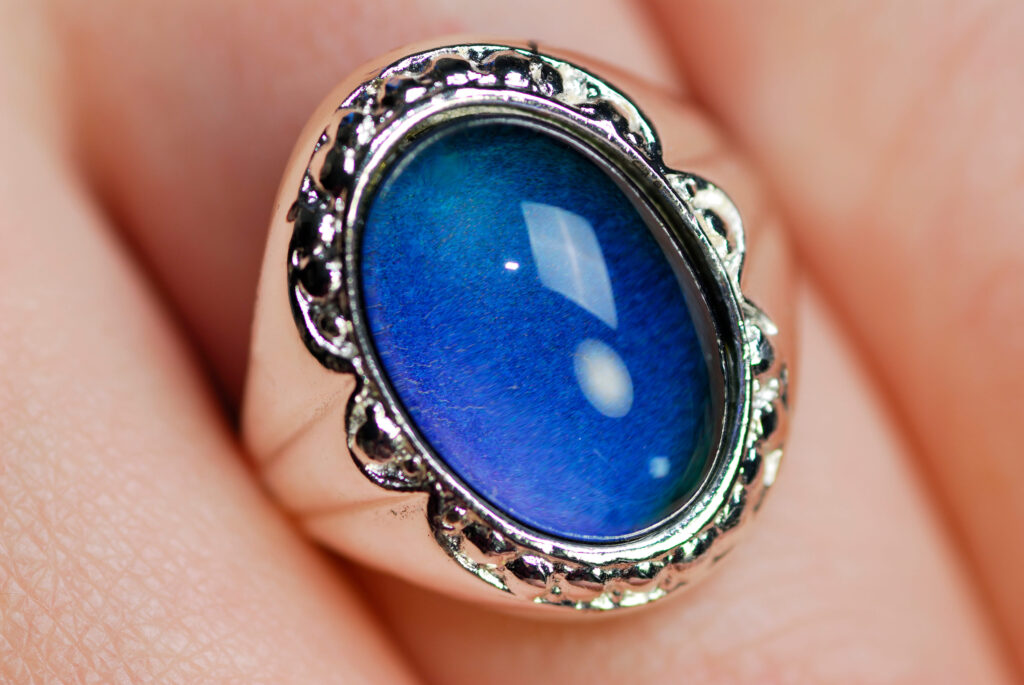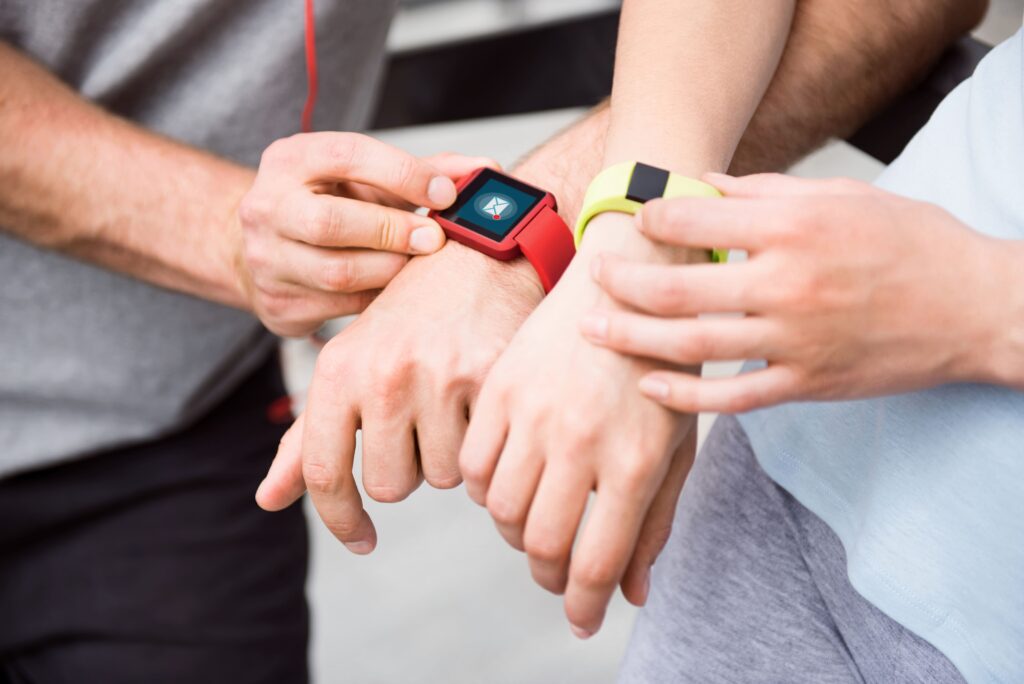If you are in school right now, you might not remember the flimsy plastic moon rings of the 70s. Don’t fret, because today’s mood rings are high-tech marvels that leave those plastic toys in the dirt. Mood rings used to be a fun accessory, but beyond the simple color shifts, modern mood rings are becoming a useful tool for your mental well-being. Wearable technology is everywhere, but there’s something nostalgic about a mood ring that we can’t put our finger on. Beyond the fun (and fashion) behind them, they stand as a promising tool for students managing stress, anxiety and other challenges that come with college.

What is wearable technology?
Picture your regular accessories: watches, glasses, maybe your shoes. Now picture them with superpowers. Wearable tech is basically your everyday accessories, except they’re souped-up with technology. It’s technology you can take with you, wear and use, and it makes life easier. A smartwatch not only tells you the time, it tracks your steps, receives your messages, monitors your heart rate. Maybe you’ll find a game or two in there! Smart glasses show you maps or take photos, and smart rings… Well, let’s discuss that a little further.
So, Mood Rings, huh…
Yup. Mood rings. Funky, colorful rings that became a big deal some decades ago. They were supposed to be in sync with you and tell you something about your mood. Have you ever not known exactly how you feel? Mood rings got you. The secret behind those mood rings is a thermochromic element, which basically means it changes color depending on body temperature. However, your mood doesn’t really change your body temperature that much, so the science behind them wasn’t super accurate. This is where smart mood rings come in!
If you want a mood tracker you will need one of the new mood rings, the smart ones. If you haven’t heard about everything that the OG mood rings have inspired, you’re in for some interesting new information.
Mood Ring Inspired Apps
The MoodRing app is designed to help teens monitor their mood and identify patterns over time. The developers of this app believe that identifying these patterns leads to better habits and improved mood, as you gain a better understanding of your emotions. The initiative is part of the Technology of Emotions (TECH-E) Study by Dr. Ana Radovic and the Center for Adolescent and Young Adult Health at UPMC Children’s Hospital of Pittsburgh. The app features daily mood check-ins designed to engage the users, tracks activity and sleep patterns, and allows users the option to share data with parents or guardians.
Smart Rings as Mood Rings for your Mental Health
The MoodRing app is a fabulous initiative, and though it gets some inspiration from mood rings, it’s not quite what we’d call wearable technology. That’s where Happy Health comes in. They created a smart ring that aims to inform its users about their mental health. The smart ring uses biometric sensors combined with AI, and is able to monitor stress levels in real time. Happy Health CEO, Dustin Freckleton, explains it “EDA sensors measure the electrical changes that occur on the hand in response to the small amounts of sweat that start to be produced on the palm of the hand.”
In other words, when your sympathetic nervous system, which is part of your “automatic nervous system,” starts acting up, the ring detects the changes and alert you about your mood. Happy Ring has four skin electrodes, four light wavelengths, accelerometers, and two temperature sensors. About the mission behind it, Sean Rad, Happy Health founder, says “We tell you about your mood on an ongoing basis so you understand when you’re calm, alert, or tense.”
Sounds pretty futuristic, right? We love it. There are other wearables that get their inspiration from mood rings. The Oura Ring, for instance, is another high-tech smart ring specifically designed to track sleep, health, and well-being. Like the MoodRing app, it believes that a comprehensive understanding of your emotions allows you to better understand yourself and your body. The Oura Ring is designed to look fashionable, offering a variety of colors and starting at $299. They even collaborated with Gucci to create a $950 version!
AI, Smart Rings, and Mood Tech at Universities
Yes, we know, while these rings sound amazing, they can be expensive. How can students afford something like that? Well, colleges and universities are looking into mood rings as wearable technology. There are numerous programs and initiatives that might catch your eye.

Mindful Tech at The UCSD Center for Mindfulness
The University of California San Diego’s Center for Mindfulness, in Collaboration, with the Qualcomm Institute, launched the Mindful Tech program designed to explore the possibilities of wearable technology for self-awareness and emotional regulation in students. The program uses devices like the previously mentioned Oura Ring, combined with meditation apps. It is a relatively new program where participants can track their physiological responses to stress and other emotions. While the Oura Ring measures the physical changes and cues, the meditation app tracks breath rate, movements and emotions, and the combination of these two contributes to students’ self-awareness.
Mindful Tech is an exciting approach to mental health support for students by combining good practices with wearable tech, and helping students develop the skills they need to manage stress, navigate their emotions and encourage awareness. Long-term effects of the program have not been explored yet, but feedback from participants so far has been positive! Being informed of changes in emotions increases self-awareness, a better understanding of external factors, and a sense of well-being.
MoodRing 2.0 Project at Carnegie Mellon University
UCSD isn’t the only school that recognizes the potential of wearable technology in helping mental health. They know how important effectively communicating your emotions is, so they developed a pair of smart rings and a mobile app to make that emotional communication easier between users, who are able to share their moods through color choices. The rings are customizable and allow you to not only change your ring color, but also see the mood your partner last experienced.
According to Carnegie Mellon University “Users can track their emotions with MoodRing 2.0 and notice patterns in their behavior…”
While MoodRing 2.0 is designed with couples in mind, its uses are limited only by the user’s need. Whether you decide to use it with your significant other, your best friend or even your therapist, MoodRing 2.0 helps you communicate your feelings and emotions and be better in tune with yourself.
Schools are hopping on the Wearable Tech trend.
UCSD and CMU are not the only ones that see the appeal of incorporating fashion and novelty into mental health awareness and understanding. Brigham Young University’s Mind-Body Awareness Project uses EEG headsets to monitor brain activity in middle school students during math class, using technology to better understand the science behind certain emotions. Additionally, MIT’s Project Empatica developed a wristband equipped with multiple sensors to track physiological signals like heart rate, skin temperature, and electrodermal activity, then, they use the information to predict and manage stress. Again, the intention behind wearable tech in regards to mental health is allowing users to be better in tune with themselves and their emotions.
A Last Little Fun Fact
Mood rings are everywhere! Yes, we talked about how they help your mental health, identifying behaviors and patterns, and easing communication… but did we mention the coding? WVSU’s Center for the Advancement of Science, Technology, Engineering and Mathematics (CASTEM) hosted an Innovator Hub Club in 2020, where kids in grades 6 to 12 learned coding by creating their own mood ring! We know it’s not mental health, but definitely cool enough and worth mentioning.
Whether you want a fun and unique accessory, or you are looking for a little help in understanding your emotions, you can’t deny that wearable technology is revolutionizing our understanding of mental health. This evolution from the nostalgic mood rings of our childhood to sophisticated smart rings is just the beginning of an exciting era! These devices are not simple accessories, but actual tools that empower users to better manage their emotions through better understanding of themselves. Apps like MoodRing and smart rings like Happy Health’s initiative, are pioneers in mental health support. The fusion of fashion, nostalgia, fun and technology, does not only encourage self-awareness but also revolutionizes how users navigate their (frequently complicated) emotional landscapes. What we can say for sure is we are excited to see what comes from this initiative, what new projects arise and how schools and students will implement this paradigm-breaking technology in their mental health care.
So… ready for a little blast from the past to up your mental health?
Share your thoughts! We are happy to know what you think about this!


Can you be more specific about the content of your article? After reading it, I still have some doubts. Hope you can help me.
Of course! What questions do you have? We will be happy to answer them.
You did an excellent job of producing an intricate, beautiful, and well-written piece of work. The presentation is aesthetically pleasing, and the written composition is sophisticated. However, it appears that you are concerned about the possibility of presenting something that is deemed to be suspicious. Yes, I anticipate that you will be able to address this problem immediately.
Thank you so much for your thoughtful feedback! It means a lot to us that you appreciate the effort we put into creating a sophisticated and visually pleasing composition. Regarding your concern about something potentially being deemed suspicious, we’d like to understand more about what you mean. Could you clarify or provide specifics? We’re committed to addressing any issues promptly and ensuring our content meets the highest standards for our readers.
Attractive section of content I just stumbled upon your blog and I actually enjoyed account your blog posts
Wow wonderful blog layout How long have you been blogging for you make blogging look easy The overall look of your site is great as well as the content
We will definitely let our web designers know about your comment!
Usually I do not read article on blogs however I would like to say that this writeup very compelled me to take a look at and do so Your writing taste has been amazed me Thanks quite nice post
I very delighted to find this internet site on bing, just what I was searching for as well saved to fav
Glad you found us. Stay tuned for more!
Great information shared.. really enjoyed reading this post thank you author for sharing this post .. appreciated
Happy to know you like it